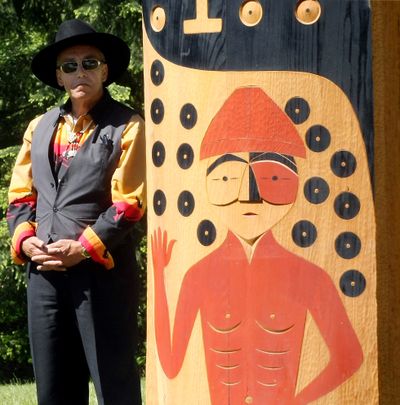New memorial tells Chief Seattle’s tale
Suquamish leader was tactical warrior

SUQUAMISH, Wash. – A bald eagle glided across the brilliant blue sky on Saturday, a pestering crow giving chase. Below, more than 100 people dedicated a renovated grave site for Chief Seattle.
The elevated-canoe memorial was 35 years old, rotting and needed to come down before it fell on somebody. The focus of its $200,000-plus replacement: two 12-foot-tall cedar poles, carved and painted to tell the famous chief’s story.
Andrea Wilbur-Sigo of the Squaxin Island Tribe was the main artist.
“It was a real honor to work on this project,” she told the crowd.
The story poles, in black and rust paint and natural cedar, show the 600-foot-long Old Man House built by Chief Seattle’s father in the mid-1770s. Above that is Chief Seattle as a boy, standing in front of sails. It depicts his sighting in 1792, at around age 6, of Capt. George Vancouver’s ships that were exploring Puget Sound. The left story pole shows Chief Seattle as a warrior, known for his tactics in heading off raids by other Indian groups, and as an older man who gave a famous speech in 1855.
Chief Seattle died June 7, 1866, at Old Man House in Suquamish and was buried in the Suquamish Tribal Cemetery. The cross-topped marble headstone that remains today was placed on the grave in 1890.
The city of Seattle provided a $100,000 grant for the work, which the tribe more than matched.
Chief Seattle descendants also were there. Mark Crowell told the group he remembers going to the grave as a child and asking his grandfather what it was all about.
“He said, ‘Mark, that’s your six-time great-grandfather,’ ” Crowell said. “I thought that was kind of cool.”
He said the renovated site is beautiful, and he’s proud of it.
Chris Endresen, a former county commissioner, compared the monument to the Suquamish people and the Kitsap County town that bears their name.
“It’s different than it used to be, but the tribe is different than it used to be and Suquamish is different than it used to be,” she said. “I know the joy and prosperity that have come in the last few years are going to continue.”